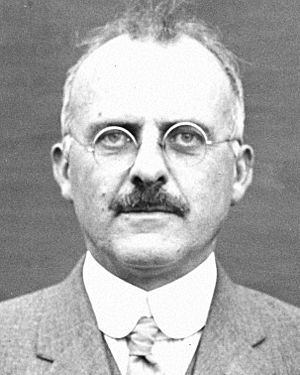Heber Doust Curtis facts for kids
Quick facts for kids
Heber Doust Curtis
|
|
|---|---|
 |
|
| Born | June 27, 1872 |
| Died | January 9, 1942 (aged 69) |
| Nationality | American |
| Alma mater | University of Michigan, University of Virginia |
| Scientific career | |
| Fields | astronomy |
| (23400) A913 CF | February 11, 1913 | MPC |
Heber Doust Curtis (born June 27, 1872 – died January 9, 1942) was an American astronomer. He was famous for studying solar eclipses and for his ideas about other galaxies existing beyond our own Milky Way. He was part of an important discussion in 1920 called the Shapley–Curtis Debate, where scientists talked about how big the universe is and what it's made of.
Contents
Life and Work of Heber Doust Curtis
Heber Doust Curtis was born on June 27, 1872. He was the older son of Orson Blair Curtis and Sarah Eliza Doust.
He studied at the University of Michigan and the University of Virginia. He earned a degree in astronomy from the University of Virginia.
Working at Lick Observatory
From 1902 to 1920, Curtis worked at Lick Observatory. He continued the work of studying nebulae that another astronomer, James Edward Keeler, had started.
From 1905 to 1909, he led the Lick southern station in Chile. After that, he returned to the main observatory to manage the Crossley telescope. In 1912, he became the president of the Astronomical Society of the Pacific.
In 1918, Curtis observed a galaxy called Messier 87. He was the first person to notice a bright, straight line coming out of it. He described it as a "curious straight ray" connected to the center of the galaxy. We now know this is a polar jet of energy.
The Great Debate
In 1920, Curtis became the director of the Allegheny Observatory. That same year, he took part in a famous discussion called the Great Debate. He debated with another astronomer named Harlow Shapley.
The debate was about the nature of nebulae and galaxies, and the true size of the universe. Curtis believed that there were many other galaxies in the universe, separate from our own Milky Way. This idea is now accepted by scientists.
Curtis's Invention
Around 1925, Curtis invented a special machine. It was called a film plate comparator. This device helped astronomers compare two large photographic plates side-by-side. It made it easier to spot changes or movements in the night sky.
Later Career
In 1930, Curtis became the director of the University of Michigan observatories. However, a lack of money during the Great Depression stopped him from building a large telescope he had designed. He also helped develop the McMath–Hulbert private observatory.
Curtis had different ideas than Albert Einstein about the theory of relativity.
Heber Doust Curtis passed away on January 9, 1942.
Legacy
The Heber Doust Curtis Memorial Telescope was built in his honor in 1950. It is located at the Portage Lake Observatory. While it no longer works, it stands as a tribute to Curtis. A small crater on the Moon, near a larger crater called Picard, was also officially named Curtis.
See also
 In Spanish: Heber Doust Curtis para niños
In Spanish: Heber Doust Curtis para niños

